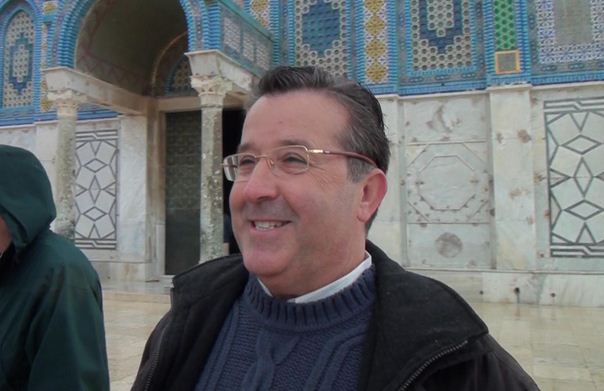- 8 كانون الثاني 2014
- أقلام مقدسية
Aida and I were driving back to Jerusalem from Al Birj in Dura.
“Whether they are Edomite, Nabataean, Jebusite, or of Canaanite or Crusader ancestry has no bearing on their sense of identity!” my adolescent daughter argued. “They define themselves primarily as Muslim, secondly as Palestinian, and thirdly as Arab; the peasants of whom you write are totally oblivious to their ancient Semitic roots.”
My daughter’s criticism summarises the pitfalls of the use of history and archaeology in the interpretation of aspects of modern Palestinian cultural expressions.
The analogical use of Biblical, archaeological, and historical discourses on ancient Semitic religious, social, and economic practices to interpret modern Palestinian customs and manners may lead to the simplistic though politically correct nationalist conclusion that the Palestinians are modern Canaanites. The analogy between modern Palestinians and ancient Canaanites throughout my research does not seek to establish a homologous relation. Rather the use of analogical argument is of a typological order and points to mutually shared patterns, regularities, attributes, or functions that have survived from ancient times to modernity. Such comparisons and metaphors drawing on analogical reasoning are heuristic and help interpret aspects of Palestinian cultural expressions within a wider temporal context.
The traditional polarity in which cultural anthropologists concern themselves with the living while archaeologists prefer the dead cannot be maintained in modern ethnography. While archaeology extends the time frame of human cultures into the distant past, it also provides valuable comparative and interpretive tools that Palestinian cultural anthropologists can use to conduct their fieldwork. The links between archaeology, ethnography, and national ideology exact a reflexive exploration that involves past and present; a hermeneutic of the diverse civilisations and cultures that have settled throughout millennia in Palestine. The term “archaeological ethnography” describes the pioneering paradigm that strives towards a thick ethnological description of Palestinian culture.
The social-cultural pattern that emerges through familiarity with a cluster of neighbouring villages is astounding. Traces of biblical significance, details of ethnographic interest, and vestiges of historical value keep prodding to provide insights that reveal the ethnic diversity that underlies the rich tapestry into which Palestinian culture has woven its unique identity throughout the past five millennia. The primordial mythos of the land is inextricably bound to the traditional relationship of the Palestinian peasants to their ancestral land as reflected in the agricultural cycle, the settlement pattern, the cave cities, the perception and use of space, the shrines and sanctuaries, and the diverse dialects.
In his recent book, Jokes and Anecdotes from Beit Jala and Beit Sahour, my friend Father Peter Madros archives an oral anecdotal humorous discourse in the local Beit Jala Arabic dialect. Father Peter narrated one of the jokes. Disappointed that I did not laugh at the punch line I apologised that I did not understand a single word of the Beit Jala vernacular. My friend tried to explain the peasant vocabulary but the humour was lost in the translation.
“You need to know ancient Semitic languages to appreciate the joke. Beit Jala Arabic dialect is interspersed with Aramaic, Hebrew, Jebusite, and other ancient Semitic dialects.”
Ethnographic fieldwork reveals a tapestry of life that has witnessed continued adaptations of the various peoples who have settled in Palestine. Each group has brought its own unique narrative to the land, such as the ecological adaptations made by the Hurrites, the original cave dwellers of Palestine, the Canaanites and their classification of nature and land use, and the evolution of the original Palestinian agricultural calendar which, during the last four millennia, was based on the cultivation of olives, grapes, figs, almonds, leeks, various species of squash and, of course, the main staple cereals, namely, wheat, barley, and lentils.
Ancient Canaanites had forged the first spiritual relationship in Palestine. Their initial perception of Palestine’s geography: the rocks, caves, water springs, and trees have come to imbue the holy land with its mythos. Their perception, intuition, and interaction with the natural environment structured and conditioned the unique socio-economic system, religion, and spiritual legacy that the diverse Semitic and non-Semitic ethnic later settlers adapted themselves to. The dynamic process of ecological adaptation to the environment, the cultural diversity of which the Canaanite nascent city-states were composed, and the influences of the various peoples with whom the Palestinians came into contact have never ceased. The rain-dependant frail ecosystem, which is vulnerable to dramatic climatic changes, has dynamically prodded an ever-shifting process of adaptations. These peoples are innumerable and include the Hurrites, Jebusites, Canaanites, Hebrews, Edomites, Arameans, and Arabs. Ancient non-Semitic peoples were composed of diverse Greeks from Crete, Ionia, the Black Sea, Anatolia, and Lydia, and were followed by Hellenic Greeks, Roman legions, Persians, Byzantines, Crusaders, Kurds, and Turks. In modern history Egyptians, British, Jordanians, and Israelis have played an ever-increasing role in reorganising the ecological system, expanding our resources in new directions, and reshaping Palestinian modern identity. Heirs to all these peoples and cultures, Palestinians can claim neither racial genetic purity nor ontological cultural homogeneity.
A major problem with using archaeology to interpret modern cultural expressions lies in the obvious fact that over time perceptions change. Each culture is a totalising closed system of signification in terms of which the various cultural expressions acquire their referential value. Homology in form does not reflect structural semantic similarity. We cannot assume that because a sanctuary or shrine (maqam) is located in a place that corresponds to the Canaanite sacred “High Place” and may have been a Canaanite sanctuary (goren) that it was used the same way in the past by, say, the Jebusites – even if the present-day people are descended from the earlier ones, or even if the people we are studying had lived in the relatively recent past. Religious symbolism and all aspects of socio-economic life are closely related to the particular details of the individual culture in a particular time and space.
The ethnographic archaeology of Palestinian culture encompasses the hermeneutics of the diverse dynamic processual cultural adaptations to an ecological system in flux. But no one can be naively romantic and assume that the present Palestinian is a modern-day Canaanite.
Ethnographic archaeology is a multidisciplinary space that brings together the poetics and politics of the present while remaining, at the same time, multi-temporal. It does not aim merely to combine and mix archaeological and ethnographic practices but to produce the ontological and epistemological possibilities of a “thick description” of Palestinian culture; a hermeneutic that engages ethnographic, archaeological, ethno-historical, biblical, educational, and artistic discourses. It builds on the experience of archaeology and cultural anthropology as well as social history, art, media, cultural studies, human geography, etc.
Within this rigorously academic paradigm ethnologists become sufficiently familiar with the historical context in which they work, thus acquiring a range of possible interpretations of the cultural expressions being observed. As such, archaeology is reconnected with ethnography in a critical, reflexive, and ethically sensitive manner.
In contemporary Palestinian culture, Judaeo-Christian symbolism and Canaanite rituals are intertwined under the veneer of Islam to such an extent as to dissolve causality. Only through extensive philological, archaeological, ethnological research can we have sufficient evidence to fathom the extent to which ancient Semitic religious practices mixed with Greco Roman paganism and survived in Christian forms or, conversely, to see that ontologically Christian rituals had been disconnected from their Christian associations and had developed under the Muslim umbrella into an independent institution, as witnessed in, for example, the Palestinian national religious figure of St. George/El-Khader, on whom I have written profusely. The proposed ethnographic archaeology perceives time and temporality in distinctive and often radically different ways, from the linear, sequential, chronometric and Cartesian time, to the time defined by the coexistence – rather than succession – of past and present.
The concept of an authentic, fixed Palestinian identity is a myth. There was never a period of true identity, a genuine moment that encapsulates a “cultural essence” or “cultural core.” Rather throughout history each period was merely a fleeting moment that in its transient fragility represented a momentary socio-economic dynamic adaptation of the culture to the available resources, thus ensuring the survival of the family within the tribe. Palestinians remain a tribal people whose elementary kinship unit was dynamically structured by the early pattern of cave dwellings that formed the ancient cities and hamlets that remained inhabited well into the twentieth century. In modernity the locus of the extended family, the sub-unit of the tribe (hamuleh) in the Palestinian village, is invariably the hosh, the three-generation family-living courtyard. Here the high school graduation parties, college graduations, engagements, and weddings are celebrated. The hosh is also the space where the four generations wile away their summer evenings.
The overlapping of Jewish narratives, Christian mythology, churches, land use agricultural calendar and ancient Canaanite cultural rituals, “High Places,” and economics in modern-day Palestinian folk culture, which academic work reveals, is partial historical reality. This academic discourse, in which the diachronic and synchronic levels of analysis merge, does not change the fact that the modern native discourse provides narratives of Palestinian identity as “Muslim” and “pure Arab”; or, if Christian, as “Christian” with “Ghassanid Arab” roots. The contemporary political ethnic identity as “Palestinian-Arab” informs one’s position vis-à-vis oneself, one’s community, and the outside world. The Palestinian exists on one level that he/she subjectively senses as real, whereas the ancient classical civilisations exist on a different plane to which the Palestinian does not relate except on an academic or political/ideological level.
After years of fieldwork, I am still overwhelmed – as I am upon seeing a flashing comet – by the sudden encounter with a socio-religious ritual; a fossil from antiquity. In its light I am touched first and foremost by the very human complexity, frailty, and pathos of the Palestinian people.
Dr. Ali Qleibo is an anthropologist, author, and artist. A specialist in the social history of Jerusalem and Palestinian peasant culture, he is the author of Before the Mountains Disappear, Jerusalem in the Heart, and Surviving the Wall, an ethnographic chronicle of contemporary Palestinians and their roots in ancient Semitic civilisations. Dr. Qleibo lectures at Al-Quds University. He can be reached at aqleibo@yahoo.com.



